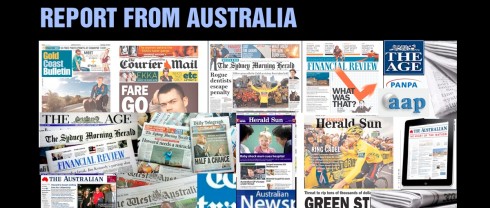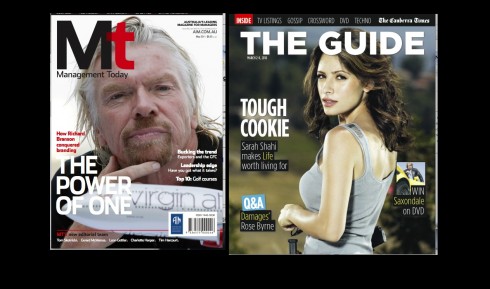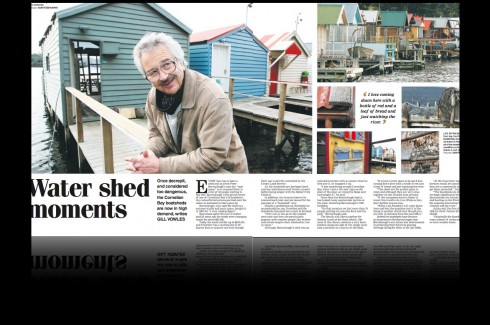TAKEAWAY: We take a look at Pagemaster, an offering from the Australian Associated Press to newspapers in which a team of copy editors and designers produce pages for a variety of sections across Australia, New Zealand and other countries. This is our Australian Report #2
This week in Australia: Part 2




All of the above pages were part of the Pagemaster production team
When we hear the word outsourcing in terms of newspaper production, we usually immediately get images of poorly executed pages in remote locations where those producing the pages have no idea what the editors and designers originating the content and visuals have in mind.
However, here in Australia, I have learned that there is such a thing as editing/production outsourcing of the classy type, where the operation is seamless—-well, almost seamless, the results impressive and everyone from editors to art directors to those producing the pages are not only synchronized but perfectly happy with the arrangement.
Indeed, I spent the day with the folks of the Australian Associated Press, conducting a workshop for both the print and digital teams. In the process, I was happy to learn about the AAP’s successful runaway Pagemasters program. in which a fantastically talented team of designers and copy editors lend their services to such titles as The Sydney Morning Herald, among others, in the copy editing and/or designing of pages that range from news to features and supplements.
The results? Impressive, to say the least. I could not imagine, as I leisurely read the Sunday edition of the Morning Herald, for example, that those supplements had been almost completely executed by the AAP team. The members of the design team walked me through all the pages they do.
Pagemasters founder and now CEO of AAP, Bruce Davidson, said the transition of subediting from newspapers to Pagemasters has been highly successful and has created centres of excellence that have in many ways reinvigorated the “craft” of subediting.
“We celebrate subediting and perform the function efficiently and productively – without compromising on quality. By outsourcing the production duties to Pagemasters, publishers and editors can focus on the issues facing newspapers around the world: the content and the effective distribution of that content,” he said.
My initial question: how do art directors who are usually so propietary about their ideas allow you to “touch” their pages?
“No problem,” I heard from Toni Caldwell, one of the lead designers. “We work together, we have learned from each other. We talk on the phone. We email, and, of course, we respect what the original design concept is for each of the titles we design for.”
Perhaps the art directors also adapt to the realities of difficult economic times when their staffs have been reduced and the outsourcing provides a way of maintaining their products alive.
In fact, sometimes it is in-sourcing that is used to remedy the situation. I know in Canada, the Postmedia Network newspaper group pulls its design resources into one center where selected number of pages are produced by a centralized team. And in Australia, Fairfax, the group that owns The Sydney Morning Herald, among other titles, has in-sourced its New Zeland operation in which they effectively pool all of their production resources across all mastheads. This achieved the same sort of efficiencies achieved through using Pagemasters. News Ltd have now adopted a similar pooled approach on state-by-state basis across Australia, my sources tell me.
This may be the shape of things to come, and, as long as the teams “mass” producing pages have direct lines to editors/art directors and respect the individuality of the publications, it may work.
Additionally, I believe that the printed newspaper of the future will be a more templated product than what we have seen in the past. Time will tell.
Australian Associated Press: moving forward
As I mentioned, my workshop yesterday was with the print/digital teams of the Australian Associated Press, and it was quite interesting to visit the facilities of this large news agency, which expands to do more than provide news information to their clients, as we see in the entry above with the Pagemaster program of offerings.
Part of our workshop was devoted to a discussion of the tablet and how information should be presented in the new platform, something of great interest to the AAP managers, who were present at the workshop.
“AAP content makes its way to all platforms across all media in Australia and we’re very proud of that. We’re continually challenging ourselves to stay ahead of the needs of our subscribers.
Presenting text, images, video and graphics for tablets require a different mindset – a ‘lean back’ approach. I see a time very soon when we’ll be producing content specifically for this purpose so we can help subscribers work effectively in this space, ” Tony Gillies, AAP editor in chief, tells me.
“It won’t just be about breaking news, which is something we’re quite good at. Tablet content from AAP will include multi-layered features and pop-up facts that will have shelf life.”
Yesterday’s workshop, no doubt, helped the AAP team to focus their attention on this next challenge for their organization and how it serves their clients.
The last of the “news drivers”?

Driver John Foster, The Sydney Morning Herald
He says he is perhaps the last “news driver” in all of Australia.
Meet John Foster, the affable, friendly news driver from The Sydney Morning Herald, with whom I had the pleasure of riding to and fro today when I visited the newsroom of one of Australia’s premiere newspapers for a talk to the team about tablet publishing.
John tells me that he is the last remaining news driver at the Morning Herald, and perhaps in the country.
“There were 8 of us at one time, those were the glory days, and I remember always carrying a photographer and a reporter together on assignment, then collecting them to bring them back to the newsroom, oh, the stories you would hear before they became real stories in print,” John tells me with a big smile, as he proudly shows me the many beautiful spots of his native city.
Not only has John been a fixture of the Morning Herald for over 30 years, but he sits in the newsroom, not in a corner of a dark garage downstairs. He is in the thick of it and “loves it.”
“News people are fun, and talkative and full of stories, this is the world I know,” he told me.
An interactive graphic of consequence
Go here for this Stanford University graphic plots over 140,000 newspapers published over three centuries in the United States. The data comes from the Library of Congress’ “Chronicling America” project, which maintains a regularly updated directory of newspapers.
http://www.stanford.edu/group/ruralwest/cgi-bin/drupal/visualizations/us_newspapers
Enter the contest
You think you have the answer to this intriguing question: What is the future of news?
Then, there is a contest you may wish to enter to offer your views on the subject. The Shorenstein Center (Harvard University) , which has been at the forefront of understanding the impact of the press on politics and public policy for 25 years, is sponsoring a contest to find an answer to that question.
For those interested, go here:
http://www.hks.harvard.edu/presspol/news_events/archive/2011/25-anniversary_video-contest.html?utm_source=Journalist%27s+Resource&utm_campaign=affdd1c7e4-Video_Contest_to_JR_list8_15_2011&utm_medium=email